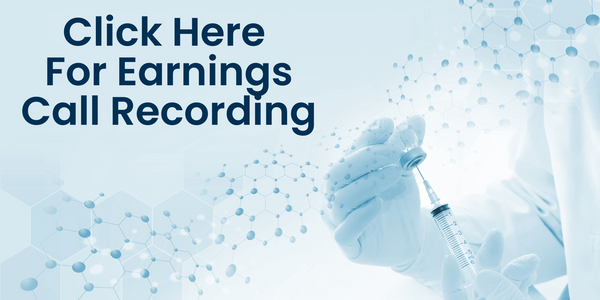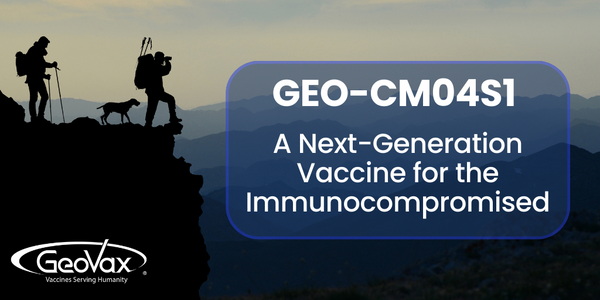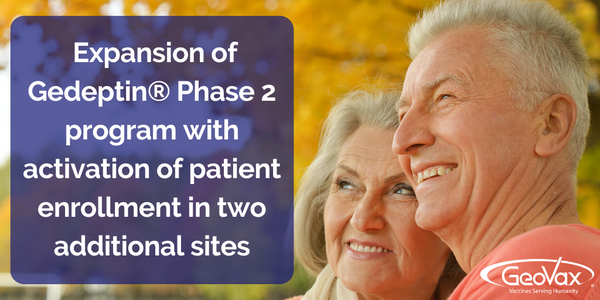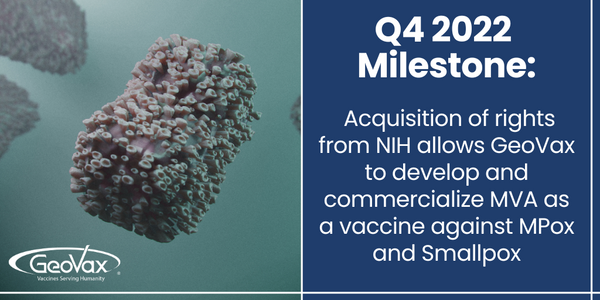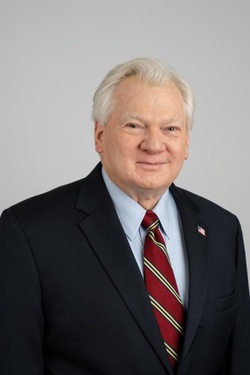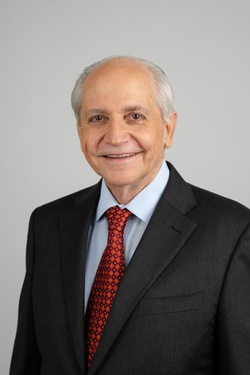
Fourth quarter 2022 represented continued progress for GeoVax as we advanced the Phase 2 clinical programs in support of Gedeptin®, our promising cancer therapy for patients with advanced head and neck cancers, and GEO-CMO4S1, our next generation COVID-19 vaccine focused on the unmet needs of immunocompromised patients.
We also continue to advance our overall development stage programs. This includes our MUC1 cancer immunotherapy currently in IND supportive studies. Also the preclinical studies evaluating Gedeptin in conjunction with immune checkpoint inhibitors continue to be encouraging with relevant data expected this year.
Throughout 2022, we strengthened our balance sheet during a very difficult investment environment, especially for the biotech industry. As a result of our successful financings last year, we've expanded our current clinical programs to include additional sites, while also adding near term opportunities related to our manufacturing processes and the additional oncology programs.
Recently, we announced the expansion of our Gedeptin Phase 2 clinical program with the activation of patient enrollment in the two additional sites at Emory University and Thomas Jefferson University. For our COVID-19 vaccine program, we implemented a novel, mobile clinical research facility in Claremont, California to support our Phase 2 COVID-19 vaccine booster trial.
Additionally, multiple sites are in the process of joining our Phase 2 COVID-19 trial among immunocompromised patients, including some potential sites outside the U.S. There is significant interest in participating in the evaluation of our novel COVID-19 vaccine targeting the high risk immunocompromised patient populations.
During the fourth quarter, we also announced the acquisition of the rights from the NIH allowing GeoVax to develop and commercialize their MVA as a vaccine against monkeypox (or MPox) and Smallpox. Our intent is to be the first and primary U.S.-based supplier of a MVA vaccine against MPox and Smallpox, resulting in expanded supply and access worldwide, especially related to low and middle income countries, which have consistently experienced significant difficulty in supply of many critical vaccines and therapies.
Finally, we recently announced our successful progress towards becoming the first vaccine supplier using an avian cell line based manufacturing process, significantly expanding the yield and capacity of MVA based vaccines. This will allow us to reduce supply chain risk associated with the use of chicken eggs and to provide the means to greatly expand production cost scale to address potential global needs again, especially related to lower cost alternatives for supply to the low and middle income countries.
Our mission is to provide immunotherapies and vaccines that improve lives worldwide, preventing or treating some of the world's most challenging cancers and infectious diseases. Our business strategy of partnering and collaborations is anticipated to allow us to provide worldwide access to our products while providing optimal value to our stakeholders. We believe that Gedeptin, CMO4S1 and our other initiatives provide significant value expansion opportunities for the company, our shareholder and stakeholder, while providing compelling career development opportunities for the members of our team.

As a reminder, Gedeptin is a cancer therapy currently an expanded multisite evaluation among patients suffering from advanced head and neck cancers. The product has received orphan drug designation from the FDA and funding for the current clinical trial is from the FDA orphan drug's clinical trials program. Our focus is on completing the initial 10 patient studies funded by the FDA. We will review those results with the FDA along with our recommendations for an expanded program, while also discussing with the FDA the potential for an expedited biologics license application filing.
We are excited about the outlook and promise of Gedeptin within advanced head and neck cancer as well as other opportunities and indications relative to the expanded use of Gedeptin. This includes the potential application of the underlying technology in conjunction with other therapies such as immune checkpoint inhibitors and potential synergy with our internally developed MUC1 tumor-associated antigen approach.
Relative to commercialization, we anticipate partnering and collaborations in support of worldwide use for which business development activities have been initiated. The vast array of unmet medical needs within oncology represents significant opportunities for GeoVax to advance novel approaches such as that of Gedeptin therapy against multiple tumors, Gedeptin in conjunction with immune checkpoint inhibitors and the GeoVax MUC1 cancer immunotherapy approach, addressing various cancer patient needs worldwide.
As previously mentioned, we hold worldwide rights for the use of Gedeptin, and the GeoVax tumor-associated antigen technologies in all indications. Our plans include the successful development of commercialization globally in conjunction with collaborators and partners.

GEO-CMO4S1, which we refer to as CMO4S1, is in Phase 2 clinical development as COVID-19 vaccine, targeting both the antibody and cellular arms of the immune system. The goal is to provide a more robust and durable protection than the currently authorized vaccines, especially for immunocompromised individuals. This vaccine holds promise over the current authorized vaccines from several critical areas of differentiation and value to various patients.
CMO4S1 is being developed to address those patient populations of immunocompromised individuals currently and adequately served by the authorized vaccines and the various monoclonal antibody therapies. A recent article in The New England Journal of Medicine addressed the critical need to address both antibody and T-cells relative to protection against SARS-CoV-2 infection and COVID-19.
CMO4S1 is specifically constructed to conclude a broader focus on the SARS-CoV-2 virus, including both the spike protein and the nucleocapsid protein, resulting in strong humoral and cellular immune responses. As a result, it induces strong antibody and T-cell responses. Such immune responses were validated and reported last year in the Lancet Microbe publication of the Phase 1 data.
Addressing the cellular immune responses via inclusion of the nucleocapsid protein is especially critical among those patient populations, who have immune systems with a blade of ability to mount a response to antibody stimulation. This includes patient populations with various blood cancers, HIV, sickle cell anemia, kidney disease, autoimmune disease and others with various comorbidities.
We estimate at least 15 million such individuals in the U.S. alone and over 200 million patients worldwide. We believe that CMO4S1 has the potential to address a critical worldwide medical need and commercial opportunity. We also believe that an opportunity for an expedited regulatory path may exist for such a development program. With CMO4S1, we also anticipate partnering and collaborations to occur for worldwide distribution, providing a novel vaccine as support for patients with such compromised immune systems.

Regarding 2023 milestones, our focus this year includes accelerating efforts in support of the Gedeptin and CMO4S1 Phase 2 clinical programs, moving the GeoVax MVA vaccine related to MPox and Smallpox development and advancing our MVA manufacturing process into operational validation. During the first half, we anticipate reporting initial clinical results of the safety lead in for the CMO4S1 immunocompromised trial.
Presentations are scheduled for the World Vaccine Congress in early April, the Vaccine Summit 2023 in late May, as well as the International Society for Advancement of Cytometry (ISAC) meeting in late May. In addition to the recently reported side expansion of the Gedeptin study, we anticipate reviewing initial data later this year.
Also this year, we anticipate reporting further preclinical information related to the use of the Gedeptin technology used in conjunction with immune checkpoint inhibitors. Furthermore, we intend to provide updates relative to IND supportive studies of our advancing GeoVax MUC1 tumor associated antigen therapy. In early June, our team will be actively participating in ASCO 2023.
During 2022, we strengthened our balance sheet, adding $37 million during a time when many biotech firms were furloughing programs and/or people. We feel that our capital development success reflects investor support and belief in the value and growth opportunities underway at GeoVax. We continue to receive strong interest related to capital investment development, which we'll evaluate, but we're focused on execution towards our 2023 goals, strengthening shareholder value and achieving critical reporting milestones for our current development programs.

Starting with our income statement, the first thing to note is the lower grant revenues reported during 2022 as compared to 2021, which is reflective of the wind down of our grants from the U.S. Army and NIH for our loss of fever and COVID-19 preclinical programs, as we focused attention on our clinical programs. We do however intend to seek additional non-dilutive government funding for our preclinical development programs in the future.
Research and development expenses were $9.1 million for 2022 versus $15.6 million for 2021, representing a decrease of $6.4 million. It should be noted, however, that the 2021 expense included $12.3 million of license fees and other upfront costs related to our licenses of CMO4S1 and Gedeptin.
Excluding these costs, our R&D expense actually increased by $5.9 million. These increases were planned and expected as they were associated with new clinical trial activity for CMO4S1 and Gedeptin, including manufacturing costs for clinical trial materials. The increase is also reflective of higher personnel and consulting costs as we stacked up earlier in the year.
General administrative expenses were $5 million for 2022, as compared to $3.6 million in 2021 with the increases associated with higher personnel, consulting and patent costs. So overall net loss for 2022 was $14 million or $0.83 per share versus $18.6 million in 2021 or $3.04 per share. Again, the increases during 2022 are primarily associated with the ramp up of organizational infrastructure and other costs associated with CMO4S1 and Gedeptin clinical trials.
Turning now to the balance sheet. Our cash balances at December 31 were approximately $27.6 million, as compared to $11.4 million at the end of 2021. The change in our cash balances for 2022 is reflective of $19 million used in operating activities, offset by proceeds from stock offerings in January and May with combined net proceeds to us of nearly $28 million and an additional $7.6 million proceeds from exercised warrants during the third quarter of last year. Our outstanding common shares now stand at $26.3 million.
In summary, we are well positioned to accelerate and advance our clinical programs with a cash runway, sufficient to fund our operations and priority programs to the end of 2023. Funding our three ongoing Phase 2 clinical programs and preparing for the next stages of development are the most significant use of our cash and our top financial priority.

Jason Kolbert, Dawson James
First on Gedeptin, at what point do you think you hit it proof-of-concept. Phase 1/2 trial, at what point do you walk away and say, yeah, this thing works?
Kelly McKee, Chief Medical Officer
That's really kind of a hard question to answer. We have proof-of-concept in a general sense from the Phase 1 study that's already completed in that we demonstrated that ejection of tumors with Gedeptin and followed by fludarabine infusions shrink the tumors. Now, this is palliative therapy, so we have no expectation that we're going to improve overall survival or even necessarily length in survival, but we do have proof-of-concept already that this technology will shrink tumors.
The current study is designed to follow-up that initial trial by giving repeat administrations of Gedeptin and repeat with fludarabine infusion following to activate the protein inside the tumor. And sort of assess not only sort of what the safety profile is, with repeat administration. But to see whether we're seeing an accelerated benefit or an expanded benefit in shrinking tumors.
It's a small number of patients. We've now enrolled eight of our target 10 and once the study is completed and we start looking at all the data, qualitatively as well as quantitatively, I think have a better sense for that and that information should start to become available towards the end of the summer, given sort of the timelines of the trial itself.
Jason Kolbert
What's the best case scenario that you'd like to see?
Kelly McKee
Best case is, we take our data package to the FDA and they look at it and tell us, if you can give us similar data in additional reasonable numbers of patients– we don't know what that reasonable number would be– we were initially hoping it would be somewhere in the neighborhood of 20 to 40, but it's probably going to be more than that. But then we could achieve an accelerated approval for this as an unmet medical need. But, again it depends on what the data looks like when we finish the trial and what the environment at the FDA is in terms of accelerated approvals for these kinds of therapies at the time that we present it to them.
Jason Kolbert
Similar question on the COVID vaccine program, two Phase 2 trials, what's the next focal point that we should be looking at in terms of that data set?
Kelly McKee
So the two trials that we have ongoing, one of them is in healthy individuals, as a heterologous booster and we're about between a third and a halfway through enrollment. With the addition of our new clinical site, we anticipate accelerating enrollment dramatically and hope to have that study fully enrolled within the next couple of three months at worst.
And given the follow-up that can -- the primary endpoint -- primary immune marker endpoint is a month or so after the booster. So we should start seeing some of that data hopefully by say early quarter four of this year. The study that we've got ongoing in patients with hematologic malignancies is a much slower pace study. We've not been able to enroll that study as quickly as we had anticipated at the City of Hope National Medical Center where it was begun.
And for that reason, we've begun enlisting support of multiple other academic medical centers. And by summer time, we should have a handful of those lined up in enrolling patients. So I wouldn't anticipate any significant readouts of that for my best guess, a year, something like that. Just because these patients -- it's hard to find patients that meet the eligibility criteria for this trial.
Jason Kolbert
My last question is really understanding the importance of the MVA manufacturing process. What I'm thinking here is that what you're saying is, in the event that there is another pandemic, the ability to be able to make a vaccine at scale, high capacity, high yield quickly becomes critical obviously, you're differentiated from an mRNA process, which is a pretty rapid process too, but you're making the point that you're getting away egg based vaccine technology is something in the past and you've now kind of got this critical piece in place. Is that understanding correct?
Mark Newman, Chief Scientific Officer of GeoVax
Yeah, that is the goal here. The mRNA is a platform, as you mentioned, where you can really enables you to do a rapid response. So there's a difference between a response and building a vaccine capability. So the cell line production gives us large scale, but it's also the idea is to get back to kind of the normal world of vaccines where childhood vaccines are given at a young age and you hope never to get sick rest of your life type of thing. And that's what we're looking at for our products.
Larger scale manufacturing would be needed to meet that type distribution. So it's -- we're focused on COVID, so you're always being compared to the mRNA vaccine groups, but we're actually targeting that field totally differently. So it's -- that's the issue. We can be small scale and certainly address with the current technology, smaller niche types of patient populations, but really expand it which is what's in our plans that will fit into the cell production based systems.
Vernon Bernardino, H. C. Wainwright
Hi. Thanks for taking my question. Most of them have already been asked and answered. But just wanted to follow-up on Jason's question. Regarding Gedeptin, now the kind of efficacy that we might expect from the Phase 1/2, you mentioned that eight patients have been enrolled and perhaps expect some data at the end of summer. But what kind of data would that be? Would that be just data in which you confirm that Gedeptin shrinks tumors or is there some of the kind of efficacy data you expect to announce?
Kelly McKee
Our end point measures include sort of -- we've graded these tumors under RECIST 1.1 and we will be taking tumor measurements. We'll be looking at not only the quantitative impact on injected tumors, but the potential effect on distant tumors that were not injected. And it's as much to give us a sense for or some confidence in that, what we're doing is actually benefiting patients in a meaningful way just in terms of improving their quality of life. But also sort of giving us some guidance with regard to direction for follow on studies.
There's no doubt that we're going to have to add additional patients to the 10 that we will have at the end of this trial. But whether that means we will be able to, for example, increase the amount of fludarabine we're able to give patients to give it a chance to be to activate more of the Gedeptin inside the tumor masses that are injected, whether that means we can either dial up or dial back the amount of injected adenovirus that carries the activated protein into the tumors. Those kinds of questions, we'll get some sense from where we can take this study as we go into additional patients.
Vernon Bernardino
Do you have any expectations on how many repeat cycles may be possible, especially when you're also giving fludarabine?
Kelly McKee
Well, so each cycle right now involves injection of Gedeptin through – three Gedeptin injections over a two day period followed by three days of fludarabine. Now -- and it's five cycles for each -- up to five cycles for each patient. Now whether we can add additional cycles, whether additional cycles would be useful. We really don't know that yet. And again these are questions that we want to explore as we progress the development program, but we don't have enough information right now to be able to make that decision.
Vernon Bernardino
Do you expect to discuss data from the 10 patients with the FDA, you think that will be this year?
Kelly McKee
Yeah, we are obviously sort of constrained by how quickly we can enroll these final two patients and then if these final two patients follow the entire lifecycle program, we're looking at basically six months from the time that the last patient is enrolled. So give us a month or so to analyze the data and pull it together, schedule a meeting with the FDA. So we're hoping we'll be able to get in front of them by the end of the year, but there are some factors that are sort of beyond our control in that regard.
Joanne Lee (on for Jason McCarthy), Maxim Group
Firstly from a broader perspective, do you guys have any numbers on the proportion of patients who are getting regular boosting in revaccination? And would you expect this to be sort of the addressable population for your vaccine?
Kelly McKee
When you mean patients, you mean our hematologic malignancy population or who are you talking about specifically?
Joanne Lee
Related to the COVID vaccine, I guess how many people are up to date and actively getting boosters and I guess, if your COVID vaccine that you're currently developing would be addressable to this population of patients?
Kelly McKee
I would anticipate that that, given the impact that this disease can have on an immunocompromised population of patients, virtually all of them will be getting regular boosters with mRNA vaccines according to the schedule prescribed by CDC and the cancer societies, but we don't have any specific numbers in hand. What we do know is that the response that these patients generate to mRNA vaccines is suboptimal compared to that seen in normal healthy individuals and that they remain vulnerable to contracting severe illness when they get infected with this virus.
Joanne Lee
The head and neck cancer trial, how large do you think the trial would go in terms of enrollment and what kind of response rate do you think would be clinically meaningful to advance the program?
Kelly McKee
We don't really know right now what they're going to require in order for us to be granted an accelerated approval. We have some estimates from some of our consultants that range anywhere from 80 to 120 patients. But whether that's really what they're thinking right now. We don't know.
And in terms of what sort of endpoints or what sort of readouts. Again, we don't know what the emphasis is going to be, whether it's going to be tumor response in terms of shrinkage, whether it's going to be a quality of life measure, some combination of that. We really don't know what they're going to require. And between now and our meeting with the FDA, we're going to solicit input from a number of regulatory specialists that have been working in this area to give us some thoughts and recommendations about what to present and what to propose.
Robert LeBoyer, Noble Capital Markets
I was hoping that you could discuss some of the things in the Gedeptin trial and specifically the use of the checkpoint inhibitors that was mentioned earlier. It was a mention of the dosing regimen, but I was curious as to whether you were going to have separate arms for the checkpoint inhibitors for all patients or how you are going to go about testing it, but either testing Gedeptin either alone or in combination?
Kelly McKee
Fundamentally, we don't have a study design specifically in mind at this point in time. However, we recognize the potential that adding a checkpoint inhibitor offers to a therapy like Gedeptin. they're sort of biologically plausible rationale for doing this. And there are other therapeutic agents in trials in head and neck cancer that are sort of capitalizing on this concept at the present time. So we have some ideas about how to go about doing this, but we don't have any specific design in mind at this time.
The preclinical work that's ongoing is with our collaborators at Emory University in which they've demonstrated in animal models some very encouraging results, which I think are going to support moving forward and how to move forward. Our thinking at this time and this is not meant to commit us in any way. But our thinking at this time is that offering Gedeptin plus a checkpoint in the context of new adjuvant therapy is a very appealing approach and we intend to explore that extensively as we discuss taking the program down the road in multiple different directions.
Kumar Raja, ROTH Capital
So first one with regard to the MUC1 IND filing, what needs to be done there before and also the timing. And with regard to the Gedeptin trial, what are you seeing in terms of screen failure rate? And what should we expect in terms of data at ASCO?
Kelly McKee
I'll take the Gedeptin one and then Mark will address the MUC1 question. But so we're not presenting anything at ASCO. I'm going to be go into that meeting and availing myself of the opportunity to interact with many of the key opinion leaders in the head and neck cancer field, to pick their brains to see sort of see what the state of the art is with using sort of therapeutic interventions either alone or in conjunction with checkpoint inhibitors and other immunologic– I don't want to say adjuvants– but combination with other immunologic simulators, stimulants. And so there's no data that's going to be presented at ASCO because we don't really have a complete data set to be able to present.
And what was your other question about Gedeptin before I give it back to Mark?
Kumar Raja
I was wondering what you're saying in terms of a screen failure rate there?
Kelly McKee
Screen failure, yeah. So that's really a hard question to answer because the patients that are offered to us by our site investigators are those that are sort of at the end of their other therapeutic options. And patients tend to be pre-identified at some point well in advance of the time that they're really ready to enroll in our trial. And whether they start -- whether they show a response to a current therapeutic regimen that they're on or whether they find themselves in such dire straits because of their underlying disease that they don't qualify because of abnormal blood chemistries or cardiac failure or whatever.
It's kind of all over the place. Patients aren't screened unless they sort of get to the point where they're in a position where the investigator thinks there's a reasonable chance that they could enroll in our trial. Now once they get to that point, I would guess that our screen failure rate is probably somewhere in the neighborhood of 25% to 50%.
Jeffrey Kraws, Crystal Research
Do you expect it to present any scientific papers or scientific presentations or data set presentations at any of the three scientific conferences that you're attending?
Kelly McKee
There's going to be data presented at the World Vaccine Congress in early April. There's going to be data on CMO4S1. There's going to be data presented at the Vaccine Summit in Boston in early June or maybe late May. On CMO4S1 and then there's a Cytometry Conference in May where some data that's sort of the more technical lab stuff associated with our trial is going to be presented as well.
Jeffrey Kraws
With regard to manufacturing and having that is one of your goals. If one were to look at your manufacturing validation that you want to have and just say you hope to have it by a certain date, what would you say the percentage of working towards that is complete now? I'm not asking you for what the specific guide is, would you say you're 50% there, 60% there, 80% there, just roughly.
Mark Newman
So we have different viral vector vaccines, right? So we're in the Ebola field. We've got O4S1, which is the other COVID first step towards the universal COVID vaccine. We are at least evaluating each of these with different cell lines for expression systems, and that's a stepwise process. So the first thing you want to know is that a particular virus will grow in a particular cell line and sometimes they don't. Sometimes the answer causes toxicity. And these cell lines could be duck origin or chicken origin. They're all tumor cell type lines, but with slightly different genetic variations based on the bird you get it from.
So you march through the series of events and say, which cell line supports which virus. Now for O4S1, we've actually got a choice. We've taken that along to the point where we're comfortable we could make a choice whenever we wanted to. They are produced with different manufacturing technologies. They're out there we would just have to select how we wanted to do it. So we're actually at the stage now where we're talking business terms and that would be John Sharky. I don't know that we're going to share any details on that, but that one's ready to go.
We have another candidate or another research level product where I think we would know exactly where we would go, but it's still in the mouse model. It's kind of a secondary approach, more of a universal COVID, but we're not focusing on that as much as the O4S1. So we're there, but I think you would have to say that each one of these is likely to be a specific paired system. It would be great if we could find a single manufacturer and a single cell line that would do it all for us. And I'm hopeful that maybe we'll get lucky. But realistically, we have seen variation. And so we're doing the right stuff, each of the steps for each product. So these lead product we're ready, we could make a decision.
Jeffrey Kraws
One final question is, you're seeing a lot of interest and a lot of movement out there amongst pharma companies, at least in our coverage of pharma. We're still seeing strong interest in partnering with novel companies with unique and differentiated technologies that are game changers. You're still seeing a lot of interest for potential partners?
John Sharkey, Head of Business Development at GeoVax
So, actually, I was in Basel earlier this week at the Bio Spring European Partnering meeting. And as you know, we started discussions with companies last year with a BIO. And what I can say is that I'm seeing more and more interest in -- once people understand the mission we're trying to work in. I mean, the reality is the world's gotten a little tired of COVID and the general population. And so, I'm often asked, do we need another COVID vaccine? But when you kind of lay out where we're working in the immune compromise, that the current vaccines just are not adequate to protect these people. These people are at risk.
Now, are we at the point where I could say if somebody's going to snap it up? I can't say that, but I will say that people are engaging with us and following up with us on stuff. And so, I think where we're working, we're succeeding in convincing people. There is a real need in this space and that there's a lot of attractive options in this space. And that these are patients who are normally underactive treatment. They're being medically managed. They're being managed by specialists, which means you have smaller field forces to detail them. They're easier to identify and get to. There's a lot of positives from the commercial side and working in this space.

